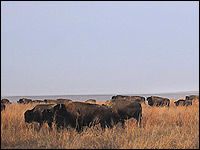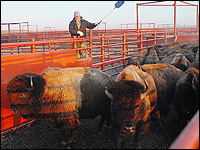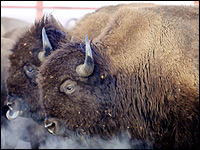
In the Oklahoma Flint Hills, an autumn moon set on The Nature Conservancy's Tallgrass Prairie Preserve as scientists and cowboys gathered at dawn recently for the annual bison roundup. Instead of horses, wranglers climb aboard trucks. They rumble toward a herd of 2,600 bison standing quietly in a nearby pasture. They drive part of the herd into a tight group, and then stampede them into a holding trap.
The shaggy beasts' heaving breath swirls through the corral into a thick, white fog. Over the next 10 hours, ranch hands use plastic paddles to spank the bison through a maze of alleys and corrals toward their annual physical.

The huge bison huffs with anxiety. Up close, he seems prehistoric - his shaggy brown head hangs low beneath a humped spine, curved horns showing bits of blood. Preserve director Bob Hamilton says he may look like a bison, act like a bison and even smell like one - but he's a cattle hybrid. And if he carries maternal cattle DNA, that could impair his metabolism and his offspring.
Culling Cattle From The Herd
Years ago, when the American bison population was at its lowest point, 60 animals were shipped to Yellowstone Park for safekeeping. The rest were taken by ranchers. Bison are strong, lean and able to tolerate extreme weather, so ranchers mated them with domestic cattle for those characteristics. The result was good for cattle, but not so good for bison.

Fertility, disease resistance and behavior could eventually be affected, too. So in a dozen other conservation herds like the one at the preserve in Pawhuska, Okla., bison carrying maternal cattle DNA are being removed.
Sequestered in their own roundup pen, bison calves mew for their mothers. Soon the calves will be pushed into the squeeze chute, where researchers will yank tail hairs for DNA testing. The discovery of cattle genes means the calf will be shipped off to a commercial livestock ranch.
"We are trying to understand what the historic genetic architecture of North American bison is and use those animals to start new herds," says Texas A&M University animal geneticist James Derr. He is studying this herd and others like it. And he's hoping such efforts will form the foundation of a conservation strategy for the species.
Out of a half a million bison in the U.S., just two tiny herds - one in Yellowstone National Park, the other in South Dakota's Wind Cave National Park - have never been crossed with cattle. So researchers are using those animals to rebuild the wild species.
The Return Of The Bison
Back at the corral, former preserve director Harvey Payne watches the roundup. He used to wander this place on horseback as a boy.
"You couldn't help but set up on one of these hills and look over the landscape and wonder what this country might have looked like several hundred years ago with large herds of bison grazing peacefully over it," Payne says.
Fifty years later, Payne is credited with restoring bison to this ancient cross-timber and post-oak savanna. That's no small miracle, says M.A. Sanjayan, lead scientist for The Nature Conservancy.
"We are seeing a bald eagle flying over this preserve today and seeing buffalo today," Sanjayan says. "It's an incredibly positive conservation story, which we need more of."
And the prognosis for the 2,600 members of this Oklahoma conservation herd? Now that most of their cattle genes have been removed, their descendants stand a better chance of survival.



Reader Comments
to our Newsletter